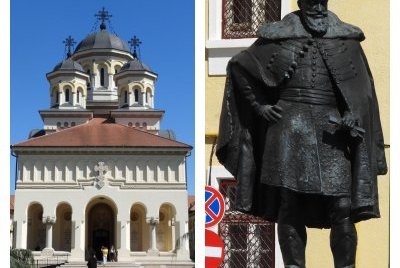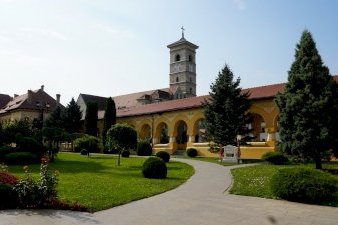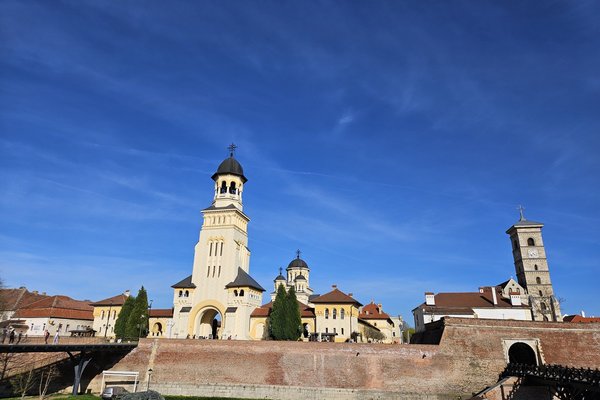Romania
Alba Julia
The historic core of Alba Julia comprises monuments from various eras.
It is centered within the fortifications of an old Roman camp. Notable buildings include the Catholic Cathedral of Saint-Michel (13th century with later additions), the Prince's Palace (16th century ) and the Unification Orthodox Cathedral (1922).
Site Info
Official Information
- Full Name
- Le noyau historique de la ville d'Alba Julia (ID: 555)
- Country
- Romania
- Status
-
On tentative list 1991
Site history
History of Alba Julia
- 1991: Added to Tentative List
- Added to tentative list
- Type
- Cultural
- Criteria
Links
- UNESCO
- whc.unesco.org
All Links
UNESCO.org
- whc.unesco.org — whc.unesco.org
Community Information
- Community Category
- Urban landscape: Urban continuity
Travel Information
Recent Connections
News
No news.
Recent Visitors
Visitors of Alba Julia
- Alexander Lehmann
- Alex Marcean
- Ali Zingstra
- Argo
- Aspasia
- BaziFettehenne
- Bin
- Cezar Grozavu
- Christoph
- Clyde
- Dimitar Krastev
- Els Slots
- Evgenii
- George Gdanski
- GeorgeIng61
- Hadrianus
- Jakob F.
- Jakubmarin
- Janina Lehmann
- Jan-Willem
- Jarek Pokrzywnicki
- JobStopar
- John Smaranda
- Jonas Kremer
- JoStof
- kutasp
- Lisu Marian
- Małgosia Łupicka
- Mateusz
- Mihai Dascalu
- nan
- Patrik
- Petri Jurescu
- Philipp Peterer
- Piotr Wasil
- Rafał Kałczuga
- Randi Thomsen
- Remigiusz
- Roman Bruehwiler
- Sclowitz
- Sergio Arjona
- Svein Elias
- Szucs Tamas
- Tamara Ratz
- Tevity
- Tsunami
- WalGra
- Wojciech Fedoruk
- Yevhen Ivanovych
Community Reviews
Show full reviews
The small Romanian city of Alba Iulia is part of the Roman Dacian Limes nomination, but the cityscape you see nowadays dates mostly from post-medieval times. Central to it is the intact Alba Carolina Citadel, built in star-shaped Vauban style in 1738. Within the citadel’s boundaries, traffic is strictly limited which adds to the pleasant atmosphere of it all and you can admire the monuments inside its walls at ease.
Alba Iulia seems to have escaped the worst of Communist building styles that characterizes so many Romanian cities. The Romanian Orthodox Coronation Cathedral (left picture) from 1922 is eye-catching in its Brâncovan style like the Horezu Monastery. Habsburg architecture is prevalent in most other buildings and preserved as an integral ensemble.
The citadel’s streets are littered with statues of historical figures, often clothed in striking robes. The 17th century Prince of Transylvania, Gabriel Bethlen (right picture) is one of them, and there’s also Michael the Brave (symbol of Romanian unity) on horseback and the Roman emperor Septimius Severus (who raised this Roman Dacian settlement to the rank of colonia).
The city also has strong ties to the (former) Romanian royal family. At the central square stands a pyramid-shaped monument with photos in their memory. And it was where the Union between the Kingdom of Romania and Transylvania was confirmed in 1918, giving Romania the borders it has today. So it all oozes history, although related to episodes hardly known outside of Romania.
I visited …
Keep reading 0 comments
Alba was a Neolithic settlement, testimonies are vestiges of the Bronze Age. Later, in the Iron one, a primal-fortress rised, and after a Dacian settlement that remained in history under the name of Apoulon.The colonization followed, with the Imperial settlements establishing the camp of the Gemina Legion, and thus appear the first forts (located on strategic routes) that form Apulum, shortly after the conquest.It is the 13th legion, on the known edge of the Empire, so it deserves to advance its headquarters to the rank of Municipium ( Marcus Aurelius) and the laurels come during the time of Commodus, when the Colony is made.In medieval times there is a document under the name of Bălgrad (etymological, „fence”).The name Alba-Carolina is only of the eighteenth century, when it appears the fortified bastion, type "Vauban" - a style imposed by the great Eugene of Savoy. For the memory of the glorious times it is preserved on the frontispieces of the access gates the imperial grandeur.It was the replica given by the Habsburgs to the Ottomans, the defensive systems in the area were protected including by bastions, and towers on the heights.The most imposing (and the oldest in Transylvania) building inside the complex is the Catholic Cathedral. Dedicated to Saint Michael, built from the Roman castrum stone, it is an architectural mix - 1000 years old.The interior became in time a royal necropolis of the Huniad family. Iancu de Hunedoara remained not only an emblematic figure of the fight for the defense of …
Keep reading 0 comments
